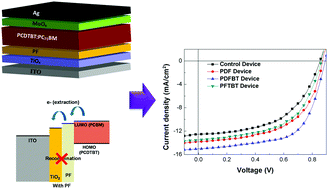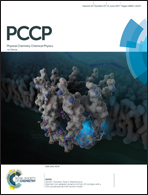Interface passivation and electron transport improvement of polymer solar cells through embedding a polyfluorene layer
Abstract
In this contribution, a series of conducting polyfluorenes (PF) are introduced to improve interface adhesion and boost charge extraction of the TiO2 electron transport layer of inverted polymer solar cells (PSCs). After employing poly (9,9-dihexylfluorenyl-2,7-diyl) (PDF), poly[(9,9-dioctylfluorenyl-2,7-diyl)-alt-co-(1,4-benzo-{2,1′,3}-thiadiazole)] (PDFBT), and poly[(4-(5-(7-methyl-9,9-dioctyl-9H-fluoren-2-yl) thiophen-2-yl)-7-(5-methylthiophen-2-yl)benzo[c][1,2,5]thiadiazole)] (PFTBT) as capping layers, interfacial coherence improvement and energy loss decrease are both achieved, facilitating charge transfer from the active layer to the TiO2 layer. The optimized contact, enhanced electrical conductivity, and reduced internal resistance contribute to increased short-circuit current density and fill factor, leading to an enhanced power conversion efficiency (PCE) from 5.72% up to 7.97%. The employment of the PF capping TiO2 buffer layer provides a promising approach to develop high efficiency PSCs.



 Please wait while we load your content...
Please wait while we load your content...